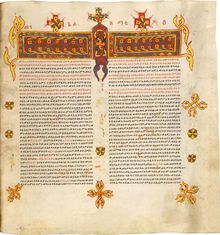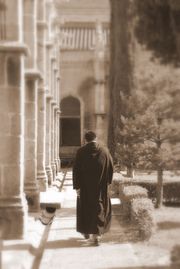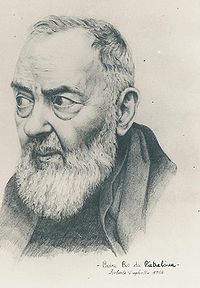Christian meditation

Christian meditation is a form of prayer in which a structured attempt is made to get in touch with and deliberately reflect upon the revelations of God.[1] The word meditation comes from the Latin word meditari which means to consider or contemplate. Christian meditation is the process of deliberately focusing on specific thoughts (e.g. a biblical scene involving Jesus and the Virgin Mary) and reflecting on their meaning in the context of the love of God.[2]
Christian meditation contrasts with cosmic styles of oriental meditation as radically as the portrayal of God the Father in the Bible contrasts with discussions of Krishna or Brahman in Indian teachings.[3] Unlike eastern meditations, most styles of Christian meditations do not rely on the repeated use of mantras, but are intended to stimulate thought and deepen meaning. Christian meditation aims to heighten the personal relationship based on the love of God that marks Christian communion.[4][5]
In Aspects of Christian meditation, the Holy See warned of potential incompatibilities in mixing Christian and eastern styles of meditation.[6] In 2003, in A Christian reflection on the New Age the Vatican announced that the "Church avoids any concept that is close to those of the New Age".[7][8][9]
Christian meditation is the middle level in a broad three stage characterization of prayer: it involves more reflection than first level vocal prayer, but is more structured than the multiple layers of contemplation in Christianity.[10]
Contents |
Context and structure
Christian meditation involves looking back on Jesus' life, thanksgiving and adoration of God for his action in sending the Son for salvation.[11] In her book The Interior Castle (Mansions 6, Chapter 7) Saint Teresa of Avila defined Christian meditation as follows:
"By meditation I mean prolonged reasoning with the understanding, in this way. We begin by thinking of the favor which God bestowed upon us by giving us His only Son; and we do not stop there but proceed to consider the mysteries of His whole glorious life."[12]

Quoting the Gospel of Matthew[11:27]: "No one knows the Father but only the Son and anyone whom the Son wants to reveal him" and I Corinthians[2:12]: "But we have received the Spirit who is from God so that we may realize what God has freely given us", theologian Hans von Balthasar explained the context of Christian meditation as follows:
"The dimensions of Christian meditation develop from God's having completed his self-revelation in two directions: Speaking out of his own, and speaking as a man, through his Son, disclosing the depths of man.... And this meditation can take place only where the revealing man, God's Son, Jesus Christ, reveals God as his Father: in the Holy Spirit of God, so we may join in probing God's depths, which only God's Spirit probes."[13]
Building on that theme, E. P. Clowney explained that three dimensions of Christian meditation are crucial, not merely for showing its distinctiveness, but for guiding its practice. The first is that Christian meditation is grounded in the Bible. Because the God of the Bible is a personal God who speaks in words of revelation, Christian meditation responds to this revelation and focuses on it, unlike mystic meditations which use mantras to block thought and erase concepts. The second distinctive mark of Christian meditation is that it responds to the love of God, as in I John [4:19]: "We love, for he first loved us". The personal relationship based on the love of God that marks Christian communion is thus heightened in Christian meditation. The third dimension is that the revelations of the Bible and the love of God lead to the worship of God: making Christian meditation an exercise in praise.[14]
Thomas Merton characterized the goal of Christian meditation as follows: "The true end of Christian meditation is practically the same as the end of liturgical prayer and the reception of the sacraments: a deeper union by grace and charity with the Incarnate Word, who is the only Mediator between God and man, Jesus Christ."[15] While Protestants view salvation in terms of faith and grace alone (i.e. sola fide and sola gratia) both Western and Eastern Christians see a role for meditation on the path to salvation and redemption.[16] Apostle Paul stated in Epistle to the Romans 9:16 that salvation only comes from "God that hath mercy".[17] The path to salvation in Christian meditation is not one of give and take, and the aim meditation is to bring joy to the heart of God. The Word of God directs meditations to show the two aspects of love that please God: obedience and adoration. The initiative in Christian salvation is with God, and one does not meditate or love God to gain his favor.[18]
Christian meditation is distinct from and contrasts with cosmic styles of oriental meditation.[19][20][21] A 1989 document generally known as Aspects of Christian meditation set forth the position of the Holy See with respect to the differences between Christian and eastern styles of meditation. The document, issued as a letter to all Catholic bishops, stresses the differences between Christian and eastern meditative approaches. It warns of the dangers of attempting to mix Christian meditation with eastern approaches since that could be both confusing and misleading, and may result in the loss of the essential Christocentric nature of Christian meditation.[22][23][24] The letter warned that euphoric states obtained through Eastern meditation should not be confused with prayer or assumed to be signs of the presence of God, a state that should always result in loving service to others. Without these truths, the letter said, meditation, which should be a flight from the self, can degenerate into a form of self-absorption.[25]
Some mystics in both the Western and Eastern churches have associated feelings of ecstasy with meditation, e.g. St. Teresa of Avila's legendary meditative ecstasy and the Eastern Orthodox approach to theosis via Hesychasm.[26][27] However, St. Augustine failed to achieve meditative ecstasy via the teachings of Plotinus[28] and St. Gregory of Sinai, one of the originators of Hesychasm, stated that the goal of Christian meditation is "seeking guidance from the Holy Spirit, beyond the minor phenomenon of ecstasy".[29] According to E. P. Clowney it is the search for wisdom, not ecstasy that marks the path of Christian meditation, a wisdom sought in the "Christ of Scripture and the Scripture of Christ".[30]
History
Old Testament
In the Old Testament, there are two Hebrew words for meditation: hāgâ (Hebrew: הגה), which means to sigh or murmur, but also to meditate, and sîḥâ (Hebrew: שיחה), which means to muse, or rehearse in one's mind. When the Hebrew Bible was translated into Greek, hāgâ became the Greek melete which emphasized meditation's movement in the depth of the human heart. Melete was a reminder that one should never let meditation be a formality. The Latin Bible then translated hāgâ/melete into meditatio.[31]
The Bible mentions meditate or meditation about twenty times, fifteen times in the Book of Psalms alone. When the Bible mentions meditation, it often mentions obedience in the next breath. An example is the Book of Joshua[Joshua 1:8]: "Do not let this Book of the Law depart from your mouth; meditate on it day and night."[32]
Lectio Divina

Daily life in a Benedictine monastery consisted of three elements: liturgical prayer, manual labor and Lectio Divina, a quiet prayerful reading of the Bible. This slow and thoughtful reading of Scripture, and the ensuing pondering of its meaning, was their meditative practice called "divine reading" or "sacred reading", or Lectio Divina.[33]
According to Jean Leclercq, OSB, the founders of the medieval tradition of Lectio Divina were Saint Benedict and Pope Gregory I in the sixth century. However, the methods that they employed had precedents in the biblical period both in Hebrew and Greek. A text that combines these traditions is the Epistle to the Romans 10:8 where Apostle Paul refers to the presence of God's word in the believer's "mouth or heart". It was the recitation of the biblical text that provided the rationale for Lectio Divina.[34]
Saint Benedict in his Rule (chapter #48) stipulated specific times and manners for Lectio Dinvina. The progression from Bible reading, to meditation, to prayer, to loving regard for God, was first formally described by Guigo II, a Carthusian monk and prior of Grande Chartreuse monastery in the 12th century. Guigo named the four steps of this "ladder" of Lectio Divina prayer with the Latin terms lectio, meditatio, oratio, and contemplatio. In Guigo's four stages one first reads, which leads to think about (i.e. meditate on) the significance of the text; that process in turn leads the person to respond in prayer as the third stage. The fourth stage is when the prayer, in turn, points to the gift of quiet stillness in the presence of God, called contemplation.[35][36]
Approaches to meditation
A number of saints and historical figures have followed and presented specific approaches to Christian meditation.
St. Ignatius of Loyola
The Spiritual Exercises of St. Ignatius of Loyola (1491–1556) - the founder of the Jesuits, contain numerous meditative exercises. To this day, the Spiritual Exercises remain an integral part of the Novitiate training period of the Roman Catholic religious order of Jesuits.[37]
The exercises are intended as notes to guide a spiritual director who is leading someone else through an experience of Christian meditation. The entire experience takes about 30 days and often involves a daily interview with the director. The process begins with a consideration of the purpose of one's life and the relationship with the rest of creation. It is followed by a week of meditation about sin and its consequences. Next comes a period of meditating on the events of the life of Jesus, and another for thinking about his suffering and death. The final week is to experience the joy of the resurrection, and in conclusion to reflect on God's love and the response of love for God.[38]
The exercises often involve imagery in which one enters a biblical scene. For example, the practitioner is encouraged to visualize and meditate upon scenes from the life of Christ, at times asking questions from Christ on the cross, during crucifixion.[39]
St. Teresa of Avila
St. Teresa of Ávila (1515–1582) a Doctor of the Church, practiced contemplative prayer for periods of one hour at a time, twice a day. St. Teresa believed that no one who was faithful to the practice of meditation could possibly lose his soul.[41] Her writings are viewed as fundamental teachings in Christian spirituality.[42][43]
St. Teresa taught her nuns to meditate on specific prayers. Her prayers described in The Way of Perfection involve meditation on a mystery in the life of Jesus and are based on the faith that "God is within", a truth that Teresa said she learned from St. Augustine.[44]
In her Life, she wrote that she taught herself from the instructions given in the book, The Third Spiritual Alphabet - by Francisco de Osuna - which relates to Franciscan mysticism.[45][46][47] Her starting point was the practice of "recollection", i.e. keeping the senses and the intellect in check and not allowing them to stray. In her meditations, one generally restricts attention to a single subject, principally the love of God. In The Way of Perfection she wrote: "It is called recollection because the soul collects together all the faculties and enters within itself to be with God".[48] She would use devices such as short readings, a scene of natural beauty or a religious statue or picture to remind her to keep her focus. She wrote that in due course, the mind naturally learns to maintain focus on God almost effortlessly.[49][50][51]
St. Theresa viewed Christian meditation as the first of four steps in achieving "union with God", and used the analogy of watering the garden. She compared basic meditation to watering a garden with a bucket, Recollection to the water wheel, Quiet (contemplation) to a spring of water and Union to drenching rain.[52]
St. Francis de Sales
Saint Francis de Sales (1576–1622) used a four part approach to Christian meditation based on "preparation", "consideration", "affections and resolutions" and "conclusions":[53]
- In the preparation part, one places oneself in the presence of God and asks the Holy Spirit to direct the prayer, as in the Epistle to the Romans[8:26]: "The Spirit helps us in our weakness, for we do not know what to pray for, but the Spirit himself intercedes for us with sighs too deep for words."
- In the consideration part, one focuses on a specific topic, e.g. a passage from the Bible.
- In the affections and resolutions part, one focuses on feelings and makes a resolution or decision. For instance, when meditating on the Parable of the Good Samaritan one may decide to visit someone sick and be kind to them.
- In the conclusion part, one gives thanks and praise to God for the considerations and asks for the grace to stand by the resolution.
20th century
From the 18th to the 20th century the non-discursive components of meditation began to be de-emphasized in some branches of Western Christianity. The non-discursive components or stages of meditative practice, which are often called "contemplation" in Western traditions, were beneficiaries of "a positive attitude toward contemplation [that] characterized the first fifteen centuries of the Christian era."[54]:145 But "a negative attitude has prevailed from the sixteenth century onward,"[54]:19 according to Thomas Keating, a Trappist monk and a primary modern expositor of the Christian meditative method of Centering Prayer. Keating attributes the emergence of a negative attitude towards contemplation to several factors, including the 17th century controversy over Quietism,[54]:23 and an increasing tendency to distinguish between "discursive meditation if thoughts predominated; affective prayer if the emphasis was on acts of the will; and contemplation if graces infused by God were predominant.... This division of the development of prayer into compartmentalized units entirely separate from one another helped to further the... notion that contemplation was an extraordinary grace reserved to the few."[54]:21
Keating states that the Spiritual Exercises of Ignatius of Loyola are "extremely important in order to understand the present state of spirituality in the Roman Catholic Church," but that there has been a "tendency to reduce the Spiritual Exercises to a method of discursive meditation."[54]:22 According to Keating,
Three methods of prayer are proposed in the Spiritual Exercises.... discursive meditations prescribed for the first week... gazing upon a concrete object of the imagination: seeing the persons of the Gospel as if they were present... [is] prescribed for the second week.... The third method... is called the application of the five senses... [and] is designed to dispose beginners to contemplation in the traditional [pre-reformation] sense of the term.[54]:22
Chinnici, a historian of Roman Catholicism in the US, wrote in 1997 that "the contemplative style of prayer came to be exiled... in the contemporary Church, contemplative prayer has yet to find a secure place."[55]:16
Denominational issues
Catholic Church
Saint Thomas Aquinas (1225-1274) said that meditation is necessary for devotion, and the Second Vatican Council called for "faithful meditation on God's word" as part of the spiritual formation of seminarians.[56]
Saint John of the Cross (1542-1591), a close friend of St. Teresa of Avila, viewed Christian meditation as a necessary step toward union with God, and wrote that even the most spiritually advanced persons always needed to regularly return to meditation.[58]
Saint Padre Pio (1887-1968), who was devoted to rosary meditations, said:[59]
"The person who meditates and turns his mind to God, who is the mirror of his soul, seeks to know his faults, tries to correct them, moderates his impulses, and puts his conscience in order."
The Catechism of the Catholic Church encourages meditation and states: "Meditation is above all a quest. The mind seeks to understand the why and how of the Christian life, in order to adhere and respond to what the Lord is asking" (Catechism item # 2705) and that Christians owe it to themselves to develop the desire to meditate regularly (# 2707). Emphasizing union with God, it states: "Christian prayer tries above all to meditate on the mysteries of Christ, as in lectio divina or the rosary. This form of prayerful reflection is of great value, but Christian prayer should go further: to the knowledge of the love of the Lord Jesus, to union with him" (#2708).[60]
Rosary meditations
The practice of meditation during the praying of repeated Hail Marys dates back to 15th century Carthusian monks, and was soon adopted by the Dominicans at large.[61] By the 16th century the practice of meditation during the rosary had spread across Europe, and the book Meditationi del Rosario della Gloriosa Maria Virgine (i.e. Meditations on the Rosary of the Glorious Virgin Mary) printed in 1569 for the rosary confraternity of Milan provided an individual meditation to accompany each bead or prayer.[62]
Saint Teresa of Avila's meditative approach of focusing on "the favor which God bestowed upon us by giving us His only Son" can be viewed as the basis of most scriptural rosary meditations.[63] In his 2002 encyclical Rosarium Virginis Mariae, Pope John Paul II placed the rosary at the very center of Christian spirituality.[64] Emphasizing that the final goal of Christian life is to be transformed, or "transfigured", into Christ he stated that the rosary helps believers come closer to Christ by contemplating Christ. He stated that the rosary unites us with Mary's own prayer, who, in the presence of God, prays with us and for us. [65] and stated that: "To recite the rosary is nothing other than to contemplate with Mary the face of Christ."[66]
Eastern Christianity
During the Byzantine Empire, between the 10th and 14th centuries, a tradition of prayer called hesychasm developed, particularly on Mount Athos in Greece, and continues to the present. St. Gregory of Sinai is considered by most to be the founder of the hesychastic approach to prayer.[67] Having been, perhaps, influenced by Indian approaches, this tradition uses a special posture and breathing rituals, accompanied by the repetition of a short prayer (traditionally the 'Jesus Prayer'). "While some might compare it [hesychastic prayer] with a mantra, to use the Jesus Prayer in such a fashion is to violate its purpose. One is never to treat it as a string of syllables for which the 'surface' meaning is secondary. Likewise, hollow repetition is considered to be worthless (or even spiritually damaging) in the hesychast tradition."[68] This style of prayer was at first opposed as heretical by Barlam in Calabria, but was defended by Saint Gregory Palamas.[69][70] Coming from hesychia ("stillness, rest, quiet, silence"), hesychasm continues to be practiced in the Eastern Orthodox Church and some other Eastern Churches of the Byzantine Rite.[71] Hesychasm has not gained significance in the Western churches.[72][73]
In hesychasm the Jesus prayer, consisting of the phrase: "Lord Jesus Christ, Son of Living God, have mercy on me" is repeated either for a set period of time or a set number of times. Hesychasm is contrasted with the more mental or imaginative forms of Christian meditation in which a person is encouraged to imagine or think of events from the life of Jesus or sayings from the Gospel. Sometimes hesychasm has been compared to the meditative techniques of oriental religions and it is possible that there were interactions between Hesychasts and Sufis, but this can not be proved.[74]
See also
- Aspects of Christian meditation
- Contemplative prayer
- The Cloud of Unknowing
- Sacred Space
- Christian Meditation Music
Notes
- ↑ Christian Meditation for Beginners by Thomas Zanzig, Marilyn Kielbasa 2000, ISBN 0884893618 page 7
- ↑ An introduction to Christian spirituality by F. Antonisamy, 2000 ISBN 8171094295 pages 76-77
- ↑ Christian Meditation by Edmund P. Clowney, 1979 ISBN 1573832278 page 12
- ↑ Christian Meditation by Edmund P. Clowney, 1979 ISBN 1573832278 pages 12-13
- ↑ The encyclopedia of Christianity, Volume 3 by Erwin Fahlbusch, Geoffrey William Bromiley 2003 ISBN 9004126546 page 488
- ↑ EWTN: Congregation for the Doctrine of the Faith Letter on certain aspects of Christian meditation (in English), October 15, 1989
- ↑ Los Angeles Times, February 8, 2003 New Age Beliefs Aren't Christian, Vatican Finds
- ↑ BBC Feb 4, 2003 Vatican sounds New Age alert
- ↑ Vatican website
- ↑ Simple Ways to Pray by Emilie Griffin 2005 ISBN 0742550842 page 134
- ↑ Systematic theology, Volume 3 by Wolfhart Pannenberg, Geoffrey W. Bromiley 1997 ISBN 0802837085 page 210
- ↑ This Is Your Mother: The Scriptural Roots of the Rosary by Ronald Walls, 2003 ISBN 0852444036 page 4
- ↑ Hans Urs von Balthasar, 1989 Christian meditation Ignatius Press ISBN 0898702356 pages 9-10
- ↑ Christian Meditation by Edmund P. Clowney, 1979 ISBN 1573832278 pages 12-13
- ↑ Spiritual direction and meditation by Thomas Merton 1960 ISBN 0814604129 page 105
- ↑ Christian spirituality: an introduction by Alister E. McGrath 1999 ISBN 0631212817 pages 67-72
- ↑ Christian Meditation by Edmund P. Clowney, 1979 ISBN 1573832278 page 48
- ↑ Christian Meditation by Edmund P. Clowney, 1979 ISBN 1573832278 page 27-28
- ↑ Christian Meditation by Edmund P. Clowney, 1979 ISBN 1573832278 page 12
- ↑ Christian Meditation by Edmund P. Clowney, 1979 ISBN 1573832278 pages 12-13
- ↑ The encyclopedia of Christianity, Volume 3 by Erwin Fahlbusch, Geoffrey William Bromiley 2003 ISBN 9004126546 page 488
- ↑ Vatican website: Letter on certain aspects of Christian meditation (in German), October 15, 1989
- ↑ EWTN: Letter on certain aspects of Christian meditation (in English), October 15, 1989
- ↑ Catholicism in dialogue: conversations across traditions by Wayne Teasdale 2004 ISBN 0742531783 Page 74
- ↑ Steinfels, Peter (1990-01-07). "Trying to Reconcile the Ways of the Vatican and the East". New York Times. http://query.nytimes.com/gst/fullpage.html?res=9C0CE1D61531F934A35752C0A966958260&sec=&spon=. Retrieved 2008-12-05.
- ↑ A history of Christian spirituality: an analytical introduction by Urban Tigner Holmes, 2002 ISBN 0819219142 page 98
- ↑ An Anthology of Christian mysticism by Harvey D. Egan 1991 ISBN 0814660126 page 311
- ↑ Hans Urs von Balthasar, 1989 Christian meditation Ignatius Press ISBN 0898702356 page 8
- ↑ Encyclopedia of Christian Theology, Volume 1 edited by Jean-Yves Lacoste 2004 ISBN 1579582508 page 695
- ↑ Christian Meditation by Edmund P. Clowney, 1979 ISBN 1573832278 page 29
- ↑ Christian spirituality: themes from the tradition by Lawrence S. Cunningham, Keith J. Egan 1996 ISBN 0809136600 page 88
- ↑ Study & Meditation, by Jan Johnson 2003 ISBN 0830820914 pages 29-30
- ↑ Christian Spirituality: A Historical Sketch by George Lane 2005 ISBN 0829420819 page 20
- ↑ After Augustine: the meditative reader and the text by Brian Stock 2001 ISBN 0812236025 page 105
- ↑ Christian spirituality: themes from the tradition by Lawrence S. Cunningham, Keith J. Egan 1996 ISBN 0809136600 page 38
- ↑ The Oblate Life by Gervase Holdaway, 2008 ISBN 0814631762 page 109
- ↑ The Spiritual Exercises of St. Ignatius of Loyola by St Ignatius Loyola 2007 ISBN 1602063737 page 15
- ↑ 2000 Years of Prayer by Michael Counsell 2004 ISBN 1853116238 page 203
- ↑ Ignatius de Loyola, powers of imagining 1986 by Antonio T. De Nicolás, ISBN 0887061095 pages 123-125
- ↑ An Anthology of Christian mysticism by Harvey D. Egan 1991 ISBN 0814660126 page 413
- ↑ Spiritual direction and meditation by Thomas Merton 1960 ISBN 0814604129 page 108
- ↑ Teresa of Avila by Rowan Williams 1991 ISBN 0826473415 page vii
- ↑ "St. Teresa of Avila". Catholic encyclopedia. http://www.newadvent.org/cathen/14515b.htm. Retrieved 14 April 2010.
- ↑ Christian spirituality: themes from the tradition by Lawrence S. Cunningham, Keith J. Egan 1996 ISBN 0809136600 page 96
- ↑ Teresa of Avila: The Book of My Life by Tessa Bielecki, Mirabai Starr 2008 ISBN 1590305736 page 20
- ↑ An Anthology of Christian mysticism by Harvey D. Egan 1991 ISBN 0814660126 pages 413-415
- ↑ Teresa of Avila by Rowan Williams 1991 ISBN 0826473415 page 4
- ↑ The Way of Perfection by St Teresa of Avila 2007 ISBN 1602062609 page 160
- ↑ Teresa, a woman: a biography of Teresa of Avila by Victoria Lincoln 1995 ISBN 087395937X page xvii
- ↑ Teresa of Avila by Rowan Williams 1991 ISBN 0826473415 page 66
- ↑ Teresa of Avila: The Progress of a Soul by Cathleen Medwick 2001 ISBN 0385501293 page 64
- ↑ A history of Christian spirituality: an analytical introduction by Urban Tigner Holmes, 2002 ISBN 0819219142 page 98
- ↑ An introduction to Christian spirituality by F. Antonisamy, 2000 ISBN 8171094295 pages 77-78
- ↑ 54.0 54.1 54.2 54.3 54.4 54.5 "The History of Contemplative Prayer in the Christian Tradition" chapter 3 (pp. 19-31) in Keating, Thomas (1997). Open mind, open heart. New York: Continuum. ISBN 9780826414205. http://books.google.com/books?id=pINxHWGTa6EC&pg=PA19&dq=keating+9780826414205+history+of+contemplative+prayer&hl=en&ei=uEkmTMHCPISlnQee37S8Bg&sa=X&oi=book_result&ct=result&resnum=1&ved=0CDIQ6AEwAA#v=onepage&q&f=false.
- ↑ Joseph P. Chinnici (1997). "Culture and prayer: Towards a history of contemplation in the Catholic community in the United States". U.S. Catholic Historian (Catholic University of America Press) 15 (4): 1–16. doi:issn=0735-8318. http://www.jstor.org/stable/25154601.
- ↑ The Teaching of Christ: A Catholic Catechism for Adults by Donald W. Wuerl, Ronald Lawler 2004 ISBN 1592760945 page 350
- ↑ The Rosary: A Path Into Prayer by Liz Kelly 2004 ISBN 082942024X pages 79 and 86
- ↑ St. John of the Cross: an appreciation by Daniel A. Dombrowski 1992 ISBN 0791408876 page 168
- ↑ The Rosary: A Path Into Prayer by Liz Kelly 2004 ISBN 082942024X pages 79 and 86
- ↑ Catechism of the Catholic Church by David Bordwell 2002 ISBN 0860123243 pages 570-615
- ↑ Encyclopedia of monasticism, Volume 1 by William M. Johnston, 2000 ISBN 1579580904 page 246
- ↑ Music in the collective experience in sixteenth-century Milan by Christine Suzanne Getz, 2006 ISBN 0754651215 page 261
- ↑ This Is Your Mother: The Scriptural Roots of the Rosary by Ronald Walls, 2003 ISBN 0852444036 page 4
- ↑ The Rosary with John Paul II by George Madore, 2004, Alba House, ISBN 2894205457 page 18
- ↑ The Rosary with John Paul II by George Madore, 2004, ISBN 2894205457 page 19
- ↑ Rosarium Virginis Mariae, #3
- ↑ "Mount Athos: History". Macedonian Heritage. http://www.macedonian-heritage.gr/Athos/General/AthosHistory.html. Retrieved 12 May, 2010.
- ↑ "Hesychasm". OrthodoxWiki. http://orthodoxwiki.org/Hesychasm. Retrieved 12 May, 2010.
- ↑ The Byzantine Empire by Robert Browning 1992 ISBN 0813207541 page 238
- ↑ The last centuries of Byzantium, 1261-1453 by Donald MacGillivray Nicol 2008 ISBN 0521439914 page 211
- ↑ Parry, Ken; David Melling (editors) (1999). The Blackwell Dictionary of Eastern Christianity ISBN 0-631-23203-6 page 230
- ↑ "Hesychasm". Catholic encyclopedia. http://www.newadvent.org/cathen/07301a.htm. Retrieved 14 April 2010.
- ↑ OSV's encyclopedia of Catholic history by Matthew Bunson 2004 ISBN 1592760260 page 433
- ↑ An introduction to the Christian Orthodox churches by John Binns 2002 ISBN 0521667380 page 128

